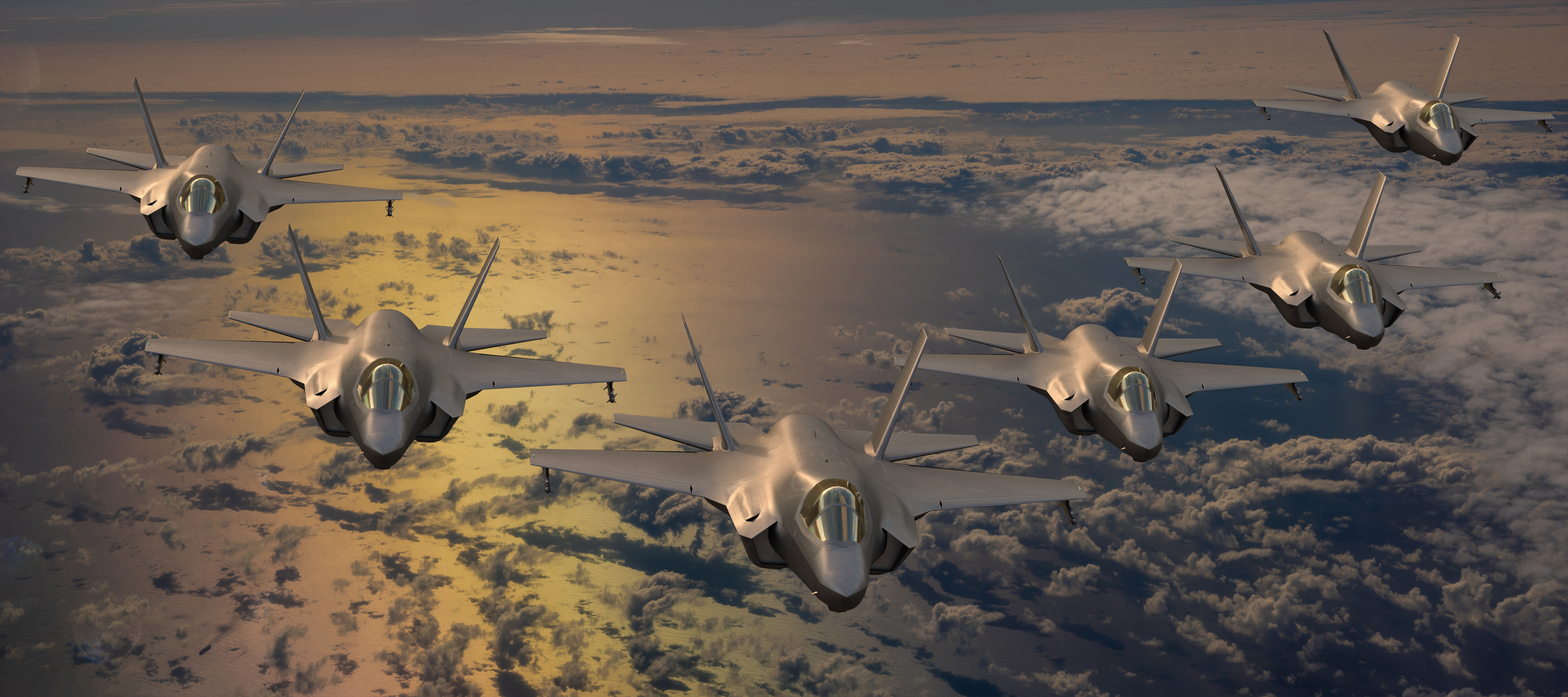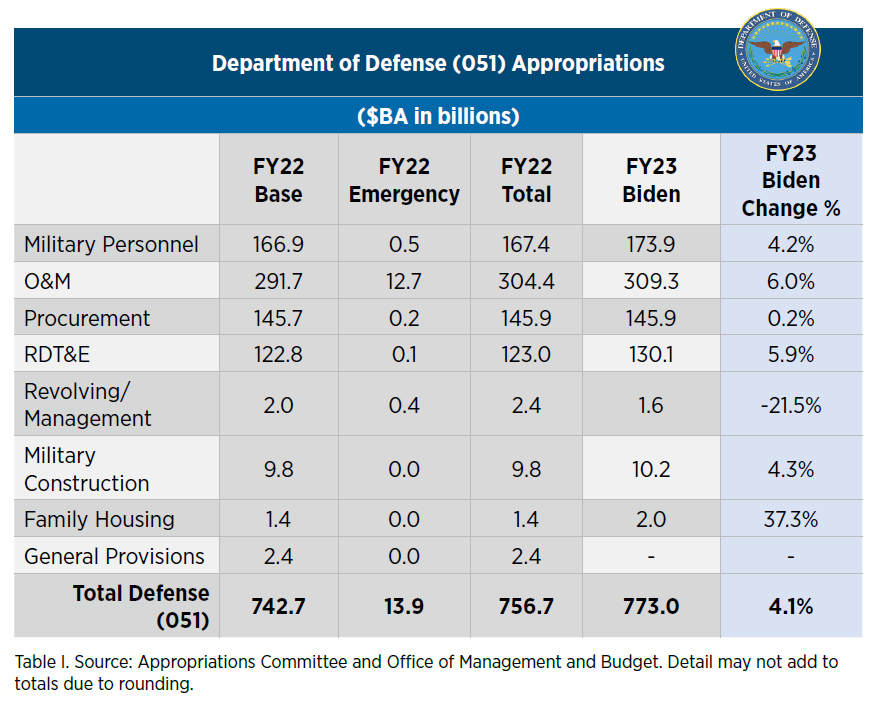

President Biden’s FY23 Department of Defense (DOD) budget was unveiled last week – 13 days after FY22 DOD appropriations were finalized. Defense Secretary Austin’s first budget features a concerted move towards modernization with robust research, development, test, and evaluation (RDT&E) funding. Austin’s modernization push will be threatened by the lateness of the FY22 appropriation, inflation, the rising cost of fuel, and Russia’s invasion of Ukraine.
The FY22 appropriation for non-emergency (base) defense spending provided DOD a 5.7% increase over FY21 non-emergency spending. The FY23 Biden budget increases non-emergency defense spending by 4.1% over the FY22 enacted levels. With the latest inflation estimate from the Bureau of Labor Statistics at 7.9% in February, a 4.1% increase results in a real loss of purchasing power. As Table I indicates, operations and maintenance (O&M) and RDT&E spending both increase faster than the topline while the military personnel accounts track the topline and procurement accounts are well below with just a 0.2% increase over FY22. Generally, Presidents’ budgets tend to have higher spending for O&M and lower spending for procurement accounts than Congress ultimately approves.
This budget assumes an inflation rate of 2.2% which is obviously incorrect because its almost 8% and it might go up, might go down. But most forecasts indicate it’s going to go up, and it could level out at nine or 10%.
General Milley, Chairman, Joint Chiefs of Staff,
April 5, 2022
Because the practical operational challenges posed by inflation and hostilities in Ukraine are largely ignored in Biden’s FY23 Budget, it represents the funding floor in FBIQ’s forecast for DOD. We expect Congress to approve some FY22 emergency supplemental assistance to Ukraine and potentially some inflation relief for DOD.


Highlights of the FY23 Biden Budget
Delayed approval of FY22 appropriations has also delayed release of DOD’s FY23 Budget details to Congress providing an overview while the detailed justification documents that normally accompany the budget are being updated. The interim justifications use comparisons to FY21 enacted levels so it’s difficult to know if the actions taken by the Congress in the FY22 appropriation would have changed the amount actually requested in the FY23 budget – most of which was prepared before FY22 action was completed. To compound the short-term analytical challenge, the Biden administration has failed to released unclassified updates of both the national security and national defense strategies foundational to the FY23 Biden DOD Budget.
The stated priorities of the FY23 budget are strengthening deterrence and responding to strategic challenges by defending the homeland, deterring strategic attacks, deterring aggression, and prevailing in conflict, and building an ecosystem that supports the Joint Force. The $276 billion investment (Procurement and RDT&E) budget request is the largest in history. The FY23 budget proposes a number of major weapon programs changes which are outlined below:
- Air Power – The budget provides $56.5 billion with a focus on F-35 and F-15EX fighters, the B-21 bomber, mobility aircraft, the KC-46A aerial refueling tanker, specialized support aircraft and unmanned aircraft systems. The budget also requests retirement of the A-10, E-3, E-8, KC-135, and RQ-21 aircraft. Some of these retirement requests have been repeated for years.
- Sea Power – The budget requests $40.8 billion for the construction of nine battle force fleet ships while continuing incremental construction of Ford class aircraft carriers and two Columbia class ballistic missile submarines. The budget also calls for the decommissioning of CG, LSD, and LCS ships.
- Land Power – The budget requests $12.6 billion for Army and Marine Corps combat equipment modernization, featuring the armored multi-purpose vehicle, the amphibious combat vehicle, and the optionally manned fighting vehicle. The budget also proposes discontinuing modifications to older night vision systems and Medium Tactical Vehicle Protection Kits.
…every dollar of increase in this budget will be eaten by inflation. Very little, if anything, will be left over to modernize or grow capability.
House Armed Services Committee
Ranking Member Rogers (R-AL),
April 5, 2022
The FY23 Biden budget requests $34.4 billion for the recapitalization of the nuclear triad by fully funding the Columbia-class ballistic missile submarine, increasing production of the B-21 bomber, fully funding the Ground Based Strategic Deterrent (GBSD) (intercontinental ballistic missile) and Long Range Standoff (LRSO) cruise missile programs, and by funding key development efforts that support Nuclear Command Control, and Communication (NC3) systems.
In addition to supporting funding for the nuclear triad, the budget requests $24.7 billion for Missile Defeat and Defense which will include development of the Next Generation Interceptor for Ground-Based Midcourse Defense, defense of Guam from China’s missile threat, development of a resilient Overhead Persistent Infrared (OPIR) capability in low and medium earth orbit, incorporation of the THAAD Battery capability into the Army’s Integrated Air and Missile Defense Battle Command System (IBCS) planning process while continuing the development of an 8th THAAD Battery, and to increase investments in regional missile defense systems.
A DOD growth area FBIQ identified — responding to climate change — receives a $3.1 billion request in this budget for projects such as installation resiliency and adaptation, science and technology, operational energy and buying power, and contingency preparedness. This budget increases the FY22 request of $617 million for response to climate change and recognizes climate change as an essential component of U.S. national security.
Hypersonic weapons technology has been in the press recently as a capability both the Russians and the Chinese have fielded in advance of the U.S. Biden’s FY23 Budget plan prioritizes fielding hypersonic weapons within the Future Years Defense Plan (FYDP) with a land-based missile battery by FY23, a maritime missile based on DDG1000 in FY25, and an air-launched missile in FY27.
Space and the assurance of maintaining security in space are critical for modernization into a fully integrated force. The budget requests $27.6 billion for space capabilities, resilient architectures, and enhanced space command and control to provide security for military, civilian, and commercial operations. Key elements include:
- $4.7 billion for missile warning
- $1.8 billion for Position, Navigation, and Timing for two GPS III follow-on satellites while continuing testing on the lead platform integration of the Military GPS User Equipment (MGUE)
- $1.6 billion to fund six launch vehicles
- $1.6 billion for satellite communications to Protected Tactical & Wideband and Narrowband robust secure/survivable/jam-resistant capabilities
The Russian invasion of Ukraine has elevated concerns about cyberspace vulnerabilities. The FY23 Budget includes $11.2 billion for cyberspace. One of the strategic objectives is to enhance cybersecurity through the implementation of a zero trust architecture and this budget helps to operationalize that architecture across the military departments and defense agencies. The budget calls for a greater involvement by U.S. Cyber Command in the acquisition of cyberspace programs and capabilities and funding to increase the number of Cyber Mission Force Teams from 137 to 142.
As we mentioned, the FY23 Budget features just over $130 billion for the RDT&E accounts, the largest ever request for modernization resources. There is $16.5 billion for Science and Technology—early-stage investigations—with $2.4 billion of that available for basic research. The budget plan includes $2 billion in Artificial Intelligence (AI) funding with an emphasis on Responsible Artificial Intelligence. The budget also anticipates establishment of the Office of the Chief Digital and Artificial Intelligence Officer which will include:
- The Joint Artificial Intelligence Center (JAIC)
- Defense Digital Service, Chief Digital Officer
- MAVEN (automation of analysis and exploitation of full-motion video),
- ADVANA (DOD’s big data platform for advanced analytics)
- Artificial Intelligence Data Accelerator (ADA), and Responsible AI, and Test & Evaluation for AI
FBIQ highlighted investments in supply chain security as another 5-year growth opportunity. Over the past few years tensions between security, reliability and efficiency have increased. DoD has identified, prioritized, and proposed funding for several areas in which critical vulnerabilities threaten national security. The budget requests:
- $3.3 billion for state of the art and state of the present microelectronics production
- $48 million for casting and forging to expand sub-tier suppliers and to improve rapid designs and reliable production
- $43 million for batteries and energy storage to ensure access to advanced battery capabilities
- $605 million to develop and expand the industrial base for hypersonic and directed energy weapons while investing in the critical chemicals necessary for missiles and munitions
- $253 million for the National Defense Stockpile to procure critical materials in an emergency
DOD faces multiple challenges. It must wrestle immediately with higher-than-expected inflation eating into its FY22 budget and planned new contract start delays after 5.5 months of continuing resolutions.
Next, we view the FY23 Biden budget as a starting point in budget negotiations. We expect this debate to include a reaction to the fact of life changes that have taken place over the past few months, including the war in Ukraine as well as inflation. While the FY22 enacted budget is more susceptible to large programmatic shifts away from the investment accounts, planned FY23 investments remain vulnerable and depend on support from Congress. As we saw in FY22, a likely topline increase reduces trade-offs between current operations and future capabilities.